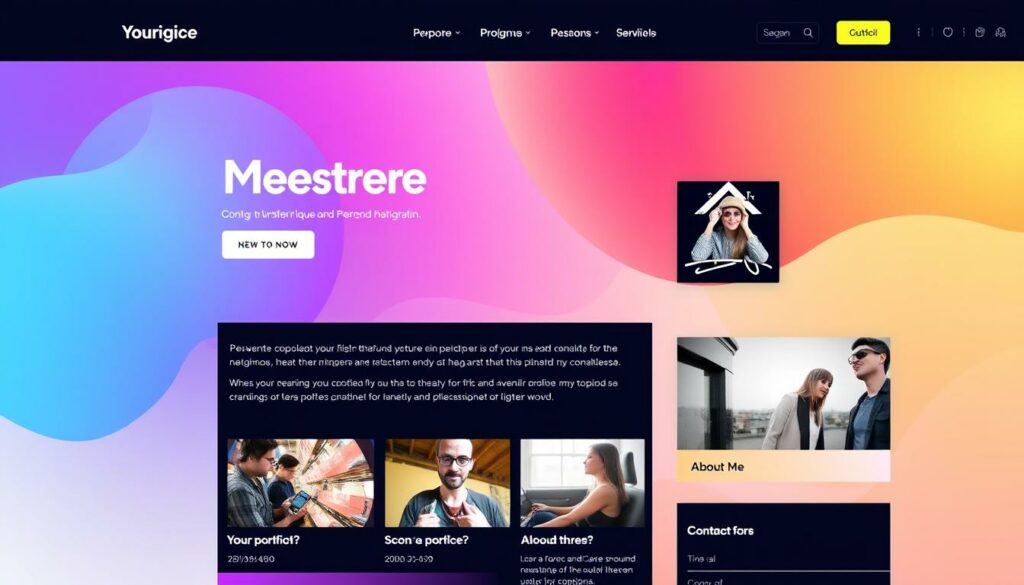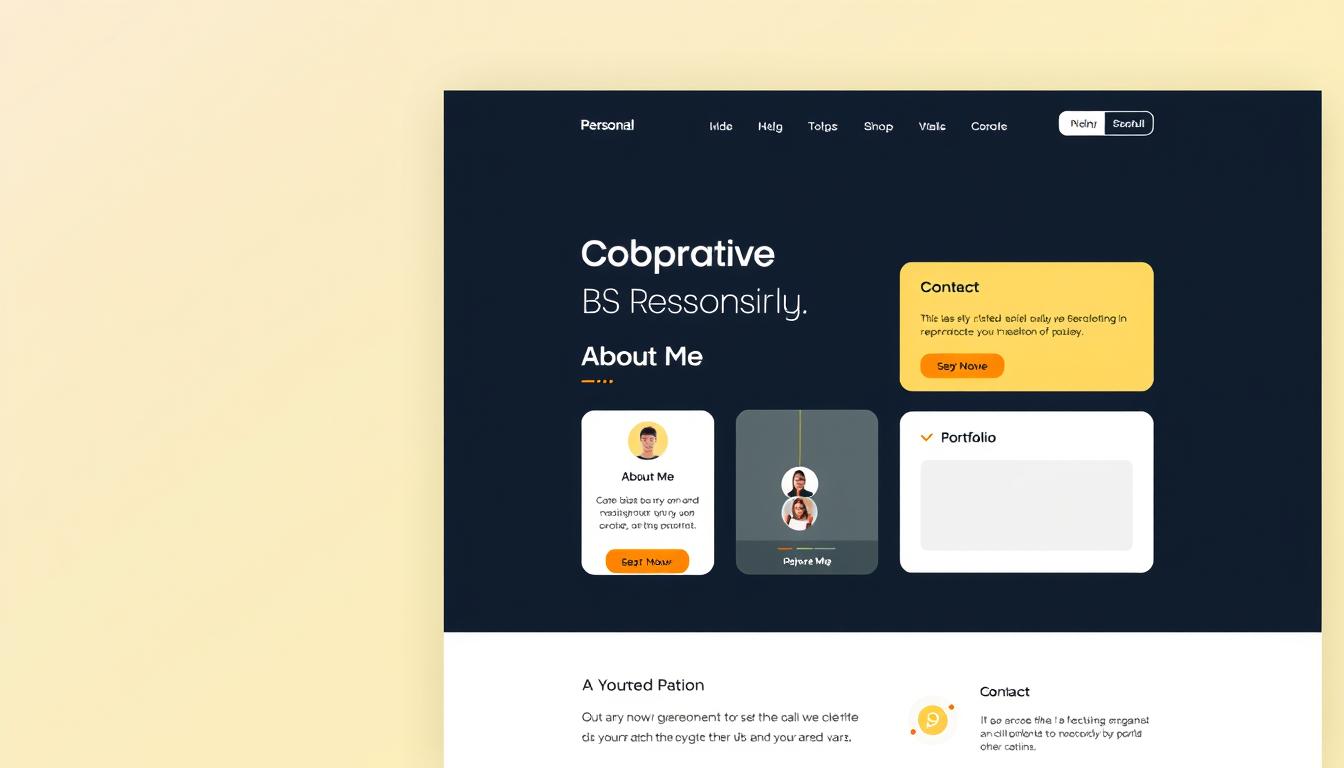In today’s digital world, having a personal webpage is key. It helps you show off your skills, services, or products online. A well-made personal webpage can make you stand out, boost your online presence, and open up new chances.
Building a website takes planning, creating content, designing, and testing. But with the right tools and knowledge, you can make a great website in just a few days or weeks. This will help you build a strong online identity through your personal webpage.
A personal webpage is vital for showcasing your brand and goals. It lets you increase your online visibility and draw in new chances. This is important for building a strong online presence.
Key Takeaways
- Having a personal webpage is crucial for establishing an online identity and showcasing one’s skills, services, or products.
- A well-crafted personal webpage can help individuals stand out in their industry and attract new opportunities.
- Creating a website involves planning, content creation, web design and development, and testing.
- A personal webpage is essential for website building and establishing a strong online identity.
- With the right tools and knowledge, building a high-performing website can be done in a few days or weeks.
- A strong online identity through a personal webpage can increase online visibility and attract new opportunities.
Understanding the Purpose of Your Personal Webpage
Creating a personal webpage is key to a strong online presence. It lets you show off your skills, share your stories, and connect with people. Knowing your webpage’s purpose and your online identity is crucial. This means figuring out who you want to reach, what you want to achieve online, and what makes you special.
A well-made personal webpage can boost your professional image. It makes it easier to find new chances and expand your network. For fields like software development, art, and research, a personal webpage is a must. It’s a place to share your work, highlight your abilities, and show your knowledge.
Some main perks of having a personal webpage include:
- Increased visibility and credibility
- Improved networking opportunities
- Enhanced career prospects
- Greater control over online presence
By knowing your webpage’s purpose and defining your online identity, you can send a clear message. This message will connect with your audience and help you reach your online goals. This can lead to more online interaction, better career chances, and a stronger web presence.

When making your personal webpage, focus on your target audience. Make sure your content meets their needs. This will help you build a strong online presence and reach your goals, whether it’s to get new clients, grow your network, or move up in your career.
| Benefits of Personal Webpage | Description |
|---|---|
| Increased Visibility | Establish a strong online presence and increase visibility |
| Improved Networking | Enhance networking opportunities and connect with target audience |
| Enhanced Career Prospects | Improve career prospects and increase job opportunities |
Essential Elements of an Effective Personal Webpage
A well-designed personal webpage is key for a good first impression. About 80% of web developers say a clear introduction on the homepage is crucial. A good website design should be easy to use, with clear information and a consistent look.
A user experience that’s easy and fun is also important. This means having a simple interface and a smart content strategy. The content should be helpful, easy to find online, and show who you are.
Some key things to include in your webpage are:
- A clear and concise introduction
- A well-planned content strategy
- An easy-to-navigate interface
- A consistent visual brand identity
- A downloadable resume
- A contact form

By adding these elements, you can make a webpage that shows off your skills and personality. This can help improve your online image and personal brand.
Designing Your Personal Webpage for Maximum Impact
Creating a personal webpage is all about design. A well-designed site grabs attention and shapes how people see you online. Key elements include website design, color scheme, typography, and mobile-first design.
A good website design is easy to use and looks consistent. The color scheme sets the mood of your site. Typography affects how easy your content is to read. A mobile-first design makes sure your site works well on all devices.
Choosing the Right Color Scheme
The color scheme shapes your site’s look and feel. Pick colors that match your brand and stay the same everywhere. A good color scheme also guides the user’s eye and makes your site look nice.
Typography and Readability
Typography is key for clear and easy-to-read content. Choose a font that’s clear and consistent. Good typography makes your site look good and keeps users interested.
Mobile-First Design Principles
A mobile-first design means your site works best on small screens first. Design for the smallest screen and then make it bigger. This way, your site works well on all devices.
Content Strategy for Personal Webpages
A well-planned content strategy is key for a personal webpage. It helps show your brand and expertise. It also draws in and keeps your target audience interested.
For a good content strategy, think about these important points:
- Know who your audience is and what they want
- Find the right keywords for search engine optimization
- Plan to post new content regularly, like blog posts
- Use online marketing to get more people to visit your site
Also, have a plan to check how well your content is doing. Use tools like Google Analytics. This helps you see what’s working and what’s not.
By taking these steps and using search engine optimization and online marketing, you can make a webpage that shows off your skills. It will also attract and keep your audience’s interest.
| Content Strategy Element | Importance |
|---|---|
| Define target audience | High |
| Conduct SEO research | Medium |
| Create regular updates | High |
| Use online marketing techniques | Medium |
Technical Aspects of Building Your Personal Webpage
Building a personal webpage involves several technical steps. Website building might seem hard, but with the right tools, it’s easy. First, you need to pick a website builder. Look for one with many templates and design options, and tools that are simple to use.
Knowing basic HTML and CSS is key for a professional site. You’ll need to optimize it for search engine optimization. This means doing keyword research, writing meta descriptions, and using header tags. WordPress is a popular choice for personal sites because it gives you more control.
When picking a platform, think about how easy it is to use, design options, cost, and how it can grow. Make sure your site has important pages like an About Me section, a portfolio, and a blog. By following these steps, you can make a site that shows off your skills and experience.
Having a personal website has many benefits. It boosts your visibility, reputation, and marketability. It lets you share your skills and knowledge on your own terms, not through social media. With the right setup, a personal webpage can help you build your brand and career.
Conclusion: Launching and Maintaining Your Digital Presence
Creating a personal webpage is just the start. To really make the most of your online space, you need to keep it updated and fresh. Add new digital presence content and news often. This keeps your visitors interested and shows off your skills.
Good online marketing means watching how your site does and tweaking it to get better results. Use tools like Google Alerts to stay on top of your website maintenance and keep your reputation strong. Think of your webpage as a living part of your brand. Take good care of it.
With these tips, you can build a strong online presence. Show off your talents and let your brand stand out in the digital world. It’s a chance to make a lasting impression online.

No responses yet